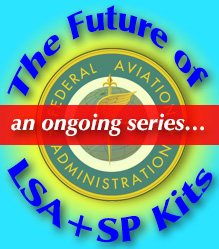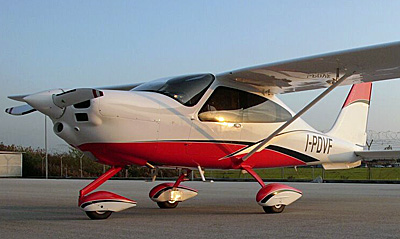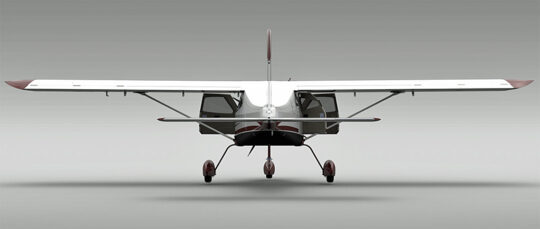Is this an exciting time for aviation? Have you been one of the many pilots anticipating Mosaic and the promise it brings for more capable aircraft? The new proposal is loaded with ideas we requested.
 As with the SP/LSA rule of nineteen years ago, these features of Mosaic are stimulating all sorts of expectations …but also some worry.
As with the SP/LSA rule of nineteen years ago, these features of Mosaic are stimulating all sorts of expectations …but also some worry.
One concern is that new four-seat mLSA with all the bells and whistles will be expensive. Well, they will be — compared to current-day LSA. Yet they will still be half the price of a roughly comparable Part 23-certified aircraft. They will also perform better while using less fuel. Plus, they will be new and nicely equipped with the latest in digital instrumentation.

Until Mosaic — companies that produced LSA but wanted to build larger aircraft had to go the route Tecnam chose for their P2010, meaning full Part 23-level certification. New competitors may give those predecessors a run for their money. ••• Click or tap the image to read about 6 other high wing mLSA candidates
Contrasting that is an entire fleet of legacy GA airplanes that many pilots have been yearning to fly using a Sport Pilot certificate (or using the no-medical feature of Sport Pilot with their higher FAA ticket). These include such as the Cessna 150, 172 and even some 182s plus a raft of other airplanes, many of which can be bought well used for half the price of a new present-day LSA. You won’t get a modern airplane, but if it fits your budget and it gets you in the air, that’s good!
Additionally, present-day LSA need do nothing to maintain all their present privileges. As such they should hold the line on prices fairly well although everything manufacturers buy (as for you and me) has gone up a lot in the last three years.
Between used GA, current LSA, kits, and mLSA to come, pilots will have more choices than ever. Here are two fresh announcements.
Stallion Four Seater
After successfully launching their Colt 100 Special LSA, Texas Aircraft is underway with their new four-seat Stallion.

Texas Aircraft’s Colt SLSA (photographed before SLSA approval) in flight at the Midwest LSA Expo. Come see the company again at next month’s event (September 2023). …MORE about Colt
Now that FAA has released their Mosaic NPRM, the American agency is catching up with Brazil’s ANAC (my article), which already published a similar regulation RBAC 01, stating that light sport aircraft can have a maximum takeoff weight of up to 3,000 pounds (1,361 kilograms) for land aircraft and a maximum stall speed without flaps of 61 KCAS. Americans may note the stall parameter is different from Mosaic: 61 vs. 54 knots. As the Stallion remains in development, Texas Aircraft could modify the design to fit Mosaic. Stallion presently lists 58 KIAS clean stall.
Planning for the regulation expansion but realizing this remains well over a year off, Texas Aircraft partnered with sister company in Brazil, Inpaer, to launch a kit for individual construction based on a 200 horsepower Lycoming engine. A second kit, but for the 260 horsepower engine, is in the final stages of construction.

Already flying in Brazil is Texas Aircraft’s Stallion four seater.
“With the publication of the regulation for the new light sport aircraft category, Texas/Inpaer registered the Stallion with the Brazilian authorities for its acceptance within the rules for Light Sport Aircraft,” reported the company. Construction of the first prototype has already begun.
Research and development flights are part of the “project validation phase and data collection for the production of the required documentation for a special light sport aircraft in compliance with the ASTM standard.”
“The Texas Group’s expectation is that the Stallion will be classified as a Light Sport Aircraft in Brazil in mid-2024,” released the company. “After the publication of the Mosaic rule, the certification process will also be started with the American authorities.”
For more information — Texas Aircraft is based in Hondo, Texas; email the U.S. company or call 830-423-2067.
Texas Aircraft
Stallion
All information supplied by the manufacturer
- Description — Single-engine, high-wing, tricycle, fixed-gear, 4 seats
- Construction — aeronautical aluminum, solid rivets, and chrome-molybdenum steel survival cell
- Maximum Takeoff Weight — 2,866 pounds
- Empty Weight — 1,653 pounds
- Fuel Capacity — 79 gallons in 4 fuel tanks
- Stall Speed, clean — 58 KIAS
- Stall Speed, best flaps — 52 KIAS
- Maneuvering Speed — 117 KIAS
- Cruise Speed — 145 KIAS
- Max Cruise Speed — 160 KIAS
- Max Continuous Power Speed — 160 KIAS
- Never Exceed Speed — 203 KIAS
Montaer’s MC-04
Thanks to their Montaer USA operation, Montaer Aeronaves became known to Americans in the last couple years after they introduced their MC-01 two-seat but three-door SLSA model.

Montaer’s MC-04 definitely resembles its two-seat sibling, MC-01, representing a worthy expansion of the original.
Right as AirVenure 2023 began, the Brazilian company unveiled its latest work, Montaer MC-04. Building upon the success of the MC-01, which boasted a high grade of craftsmanship and a sophisticated feature set among LSA, the company is reaching higher with MC-04.
Founded in 2013 by Brazilian aeronautical designer, Bruno de Oliveira — who formerly worked with Paradise Aircraft — Montaer Aeronaves developed a reputation for pushing boundaries and embracing innovation. “The integration of advanced IFR equipment and ballistic parachute further reveals Montaer’s commitment to cutting-edge advancements,” said U.S. Montaer representative Shalom Confessor. “With the MC-01 gaining full FAA acceptance as a Special LSA by complying precisely with ASTM standards, Montaer solidified its position.”

“Safety remains at the heart of Montaer’s design philosophy; MC-04 is a testament to this unwavering commitment,” said Shalom. “Its all-metal fuselage/wings/tail, welded 4130 molybdenum steel tube passenger safety cell, and solid metal rivets provide a robust structure, ensuring peace of mind during every flight. And for added reassurance, pilots can opt for a ballistic parachute.”

Montaer arrived on the scene with this three-door MC-01 SLSA. It has since been upgraded with the Rotax 915iS. …MORE about MC-01
MC-04’s cockpit features twin, large Garmin G3X Touchscreens complemented by a Garmin G5 in the top-center for added backup. “A Garmin GMC 507 Auto-Pilot System, part of the Premium Package, adds to the aircraft’s allure,” said Shalom. “An IFR version features the Garmin GTN 750Xi (GPS/NAV/COMM/MFD).”
Montaer recently established a permanent presence at DeLand Municipal Airport, Florida, to provide personalized support and training to U.S. customers.
For more information — Montaer in the USA is based in DeLand, Florida; contact Shalom via email or call 321-430-2376.
Montaer Aeronaves
MC-04
all information provided by the importer
- Powerplant — Turbocharged Rotax 916iS 160 horsepower
- Propeller — In-Flight Variable Pitch / Constant Speed
- Range — 800 nautical miles
- Cruising Speed — 132 knots
- Stall Speed (best flaps) — 49 knots
- Stall Speed (clean) — 53 knots
- Rate of Climb— 1,300 feet per minute
- Takeoff Distance (Land) — 600 feet
- Seating — 1 to 4
- Length — 23 feet
- Wing Span — 32 feet
- Height — 7.8 feet
- Empty Weight — 1,130 pounds
- Maximum Takeoff Weight — 2,198 pounds
- Useful Load — 1,068 pounds
- Fuel Capacity — 42 gallons (252 pounds)
- Baggage Capacity — 90 pounds


Dan,
I am shopping currently, having sold a 182RG. I’m looking at LSA airplanes that currently if changed to ELSA immediately give you a much more reasonable MGW. An example is of course the Jabiru. Do you have any others you think will have an increase in MGW soon either by taking it ELSA or by the Mosaic rules. Hope to see and meet you next month at the midwest LSA show
Several recent articles have touched on other LSA that will likely extend their stated maximum takeoff weight (because they were designed for a higher gross in the first place).
Think I might have missed something here. The article is touting the 4 seats and family carrying capabilities of these aircraft, but isn’t MOSAIC keeping the single passenger limitation in place for sport pilots?
You are correct, however, the same airplane can be flown by a private with basic med, and fill all seats.
I’m intrigued by all the news about what mLSA will mean for speed, weight, performance, etc. for new aircraft and manufacturing design options. I’m still a bit confused by the presentation of such airframes like the Stallion and MC-04 mentioned in the article as being a great new option in this mLSA class having a 4 seat configuration. Will mLSA still limit to having only 1 passenger onboard, or what’s all this talk of introducing a “family-size” aircraft like the MC-04 to the mLSA community?
I believe you are making a common error of mixing the aircraft description within Mosaic with the pilot privileges under the same proposal. The aircraft can most definitely have four seats and be flown by a sport pilot, but not with four people in it.
Thanks for the reply Dan! I guess that makes sense in terms of the purpose of the airplane fitting more than one class of pilot. To that end, if I were to have a PPL and own a Jabiru 230, would the Mosaic rules allow me to ‘convert’ and register that as a J430 and adding two more seats back in it? And how does a factory built vs. kit built model come into play? Thanks again!
As I read it, the proposal would not allow you to make that conversion, but the factory could do as you say, if they are willing to go through the ASTM declaration process. I feel sure they could achieve that; the question is if they wish to make the investment.
So the limitation is the type of pilot license, not the aircraft capability. If I am reading correctly one can fly with 4 passengers as long as you have a private pilot license and not a sport pilot license? Just trying to sort this out in my head as I am one of the many who is shopping for a plane and finding the prices a bit out of range. This drives us all into the LSA market for modern plane/avionics, safety features, and affordability. Sorry if this is answered in later comments!
If you have a Private or better and if you have a medical or BasicMed, yes, you can fly a Mosaic LSA with all four seats occupied (weight and balance allowing, of course). Someone exercising the privileges of Sport Pilot (no medical or BasicMed, just a drivers license) can fly the same aircraft but with only two persons on board.
I am all for revising the Light Sport rules to include legacy aircraft like the Cessna 172, but one consequence that is unavoidable is the reduction in sales of existing LSA aircraft. Aging pilots who have previously used the LSA as a means of staying in the air will now be able to keep flying their larger planes. Additionally, sport pilots having the option of purchasing a vintage C150 for under $50k may elect to do so instead spending over six figures on a newer LSA. Granted, modern avionics will continue to draw a percentage of pilots, but I’m worried that a number of LSA manufacturers will see enough of a sales drop that they won’t survive.
All Mosaic is doing is opening up the US market to European aircraft that never qualified as light sport. These legacy aircraft have their place, but future generations of sport pilots young and old will not want an old legacy aircraft that will cost more to upgrade then to just buy a newer light sport, IMO.
There are over 100 light sport aircraft now! The market has always regulated itself in terms of competition. Cirrus is a prime example. They hold the biggest share of the piston market, but people keep buying $500,000 Cessnas. Mosaic will bring out the best of the best and we will have to see what that looks like in the marketplace.
“Additionally, sport pilots having the option of purchasing a vintage C150 for under $50k may elect to do so ”
There will be more qualified pilots under Mosaic chasing after that sub $50k C150, thus increasing the cost to near the $50k price point.
There will be some crossover point in which the price of a used, “less capable” (1320 lb) LSA will come down significantly, while a vintage certificated aircraft under Mosaic will increase substantially.
“These include such as the Cessna 150, 172 and even some 182s….”
The cost of a used 172 just went up 30%.
Yep, could happen…
Very exciting times to be a light sport pilot. Dan, do you think that mosaic will put pressure on legacy LSA manufacturers to beef up their designs to make their aircraft more attractive to buyers. Aircraft like Evektor, etc.
Some will. Some have already done so. Some don’t need to do anything. A variety of choices will follow.